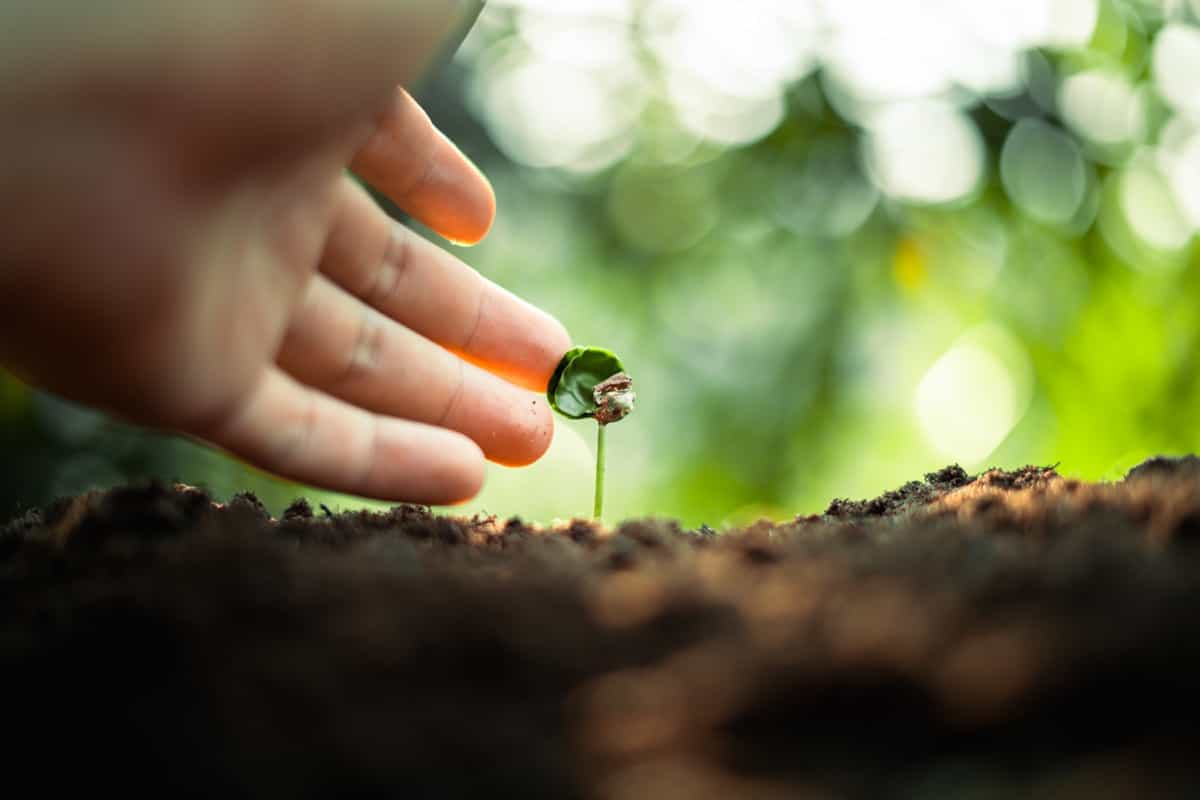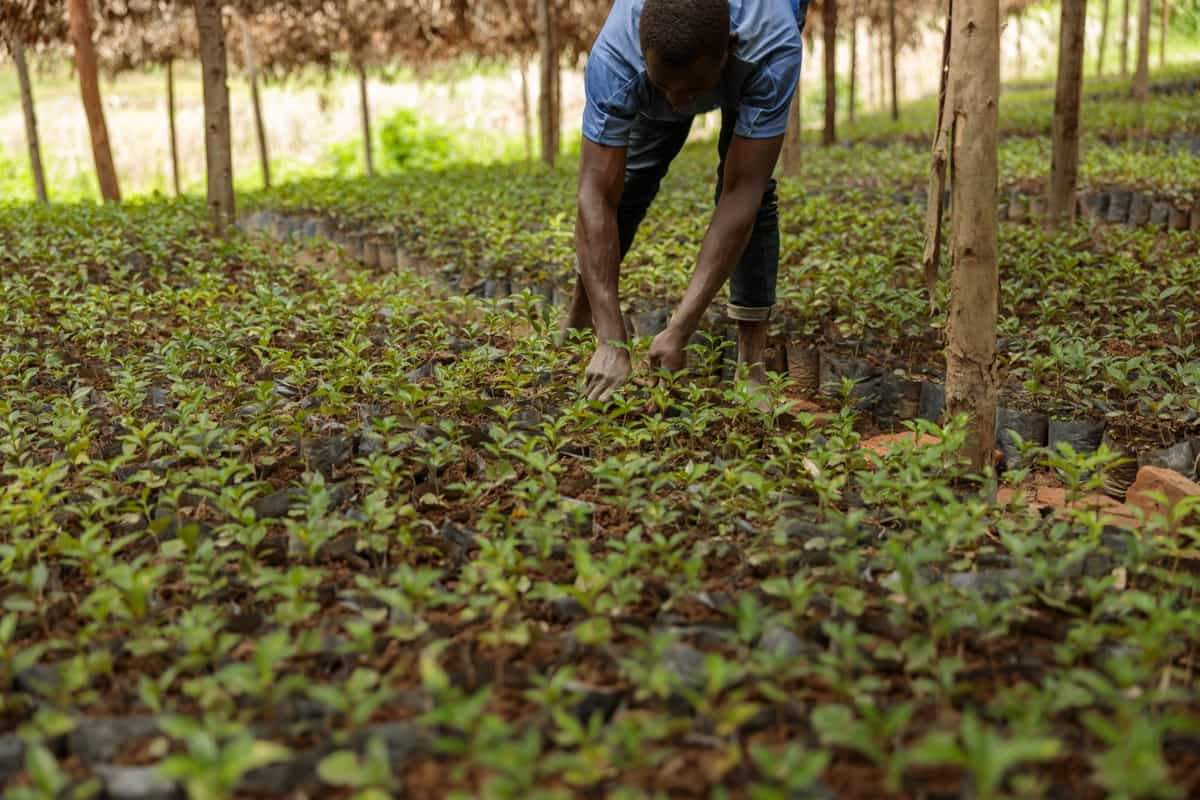The importance of coffee seed germination cannot be overstated. It determines the success of coffee cultivation, as healthy seedlings lead to robust coffee plants. Additionally, proper germination ensures genetic diversity and the preservation of desirable coffee traits. The germination process begins when the coffee seed absorbs water, triggering biochemical changes within the seed. This leads to the activation of enzymes responsible for breaking down stored nutrients, allowing the embryo to grow. As the root emerges, it anchors the seedling in the soil while the shoot reaches towards the sunlight.

Creating Seedbeds for Coffee Seed Germination
Factors Affecting Coffee Seed Germination: Light, Temperature, Moisture, and More
Light plays a crucial role in coffee seed germination. Seeds require light to trigger the process of sprouting. The optimal light intensity for coffee seed germination is around 1000 to 2000 lux. Exposing coffee seeds to direct sunlight can inhibit germination, while complete darkness can also hinder their ability to sprout. Temperature is another important factor. Coffee seeds prefer temperatures between 20 to 30°C for optimal germination.
Extreme temperatures can adversely affect germination. Low temperatures below 10°C can cause dormancy, while high temperatures above 35 °C can lead to seed damage. Moisture is vital for coffee seed germination. Seeds need adequate moisture to soften the outer seed coat and initiate growth.
However, excessive moisture can lead to fungal diseases, such as damping-off, which can damage or kill the seeds. Other factors influencing coffee seed germination include soil quality, oxygen availability, and seed quality. High-quality soil with good drainage and aeration promotes successful germination. Sufficient oxygen levels in the soil are essential for respiration and root development.
Preparing Coffee Seeds for Germination: Harvesting, Processing, and Storage
Preparing coffee seeds for germination involves several important steps: harvesting, processing, and storage. Harvesting coffee seeds should be done when the cherries are at their peak ripeness. This ensures that the seeds inside are fully mature and ready for germination. Once harvested, the seeds need to be processed to remove the outer layers. After harvesting, the cherries are processed to remove the pulp and mucilage.
This can be done using either the wet or dry method. Wet processing involves fermenting the cherries in water to remove the pulp, while dry processing involves drying the cherries under the sun before removing the pulp. After processing, the seeds must be dried to a specific moisture content to prevent mold and maintain viability. Finally, the seeds should be stored in a cool, dry place to maintain their quality until they are ready to be planted.
Creating an Ideal Environment for Coffee Seed Germination: Choosing the Right Seedbed
Firstly, the seedbed should have good drainage capabilities. Excess moisture can be detrimental to the seeds, leading to rot and fungal diseases. Therefore, choose a seedbed that allows water to drain freely, preventing waterlogging and promoting healthy root development. Secondly, coffee seeds require a loose and well-aerated medium for germination. This allows the roots to penetrate easily, access oxygen, and absorb essential nutrients.
A mixture of organic matter, such as compost or peat moss, sand, or perlite, can create an ideal texture for coffee seed germination. Furthermore, the seedbed should provide a stable temperature and humidity level. Coffee seeds germinate best within a temperature range of 20-30°C. Choose a spot that maintains a consistent temperature, avoiding extreme fluctuations. Additionally, maintaining a humidity level of around 70% can promote successful germination.
Selecting the Appropriate Soil Mix for Coffee Seedbeds: Composition and Nutrient Requirements
Selecting the appropriate soil mix for coffee seedbeds is crucial for successful seed germination and healthy plant growth. The composition of the soil mix largely depends on the specific requirements of coffee plants. Ideally, the soil mix should consist of 50% organic matter, such as well-decomposed compost or leaf mold, to provide essential nutrients and improve soil structure. The remaining 50% should combine sand, silt, and clay, ensuring proper drainage and water retention.
In case you missed it: Are Coffee Grounds Good for Tomato Plants: Benefits, How and When to Apply to Tomatoes

In terms of nutrient requirements, coffee plants need a balanced mix of macronutrients and micronutrients. Macronutrients, like nitrogen, phosphorus, and potassium, should be present in appropriate ratios, while micronutrients, such as iron, zinc, and manganese, should be available in trace amounts. Careful consideration of the soil mix composition and nutrient requirements is vital for creating an optimal environment for coffee seedbeds.
Sowing Coffee Seeds in Seedbeds: Techniques and Best Practices
Sowing coffee seeds in seedbeds requires careful attention to ensure successful germination and healthy seedlings. First, select a well-draining location with partial shade. Prepare the seedbed by loosening the soil and removing any weeds or debris. Create furrows or use trays for sowing the seeds evenly. Plant your seeds at a depth of 1-2 centimeters, cover lightly with soil, and water gently. Maintain consistent moisture levels by watering regularly but avoiding overwatering. Protect the seedbed from extreme weather conditions and pests.
Watering and Irrigation Strategies for Coffee Seedbeds: Maintaining Optimal Moisture Levels
Watering and irrigation play a crucial role in the successful growth of coffee seedlings in seedbeds. To maintain optimal moisture levels, follow a few strategies. Firstly, ensure that the seedbed soil is consistently moist but not soggy. Watering should be done gently to avoid disturbing the seeds and seedlings. Use a gentle spray nozzle or watering can to irrigate the seedbeds.
It is recommended to water early in the morning or late in the afternoon to minimize evaporation. Regularly monitor the moisture levels to prevent both underwatering and overwatering. Adjust the watering frequency according to weather conditions, ensuring the seedbeds neither dry out nor become excessively wet.
Protecting Coffee Seedlings From Pests and Diseases in the Seedbeds
To ensure the healthy growth of coffee seedlings, it is crucial to protect them from pests and diseases in the seedbeds. Start by selecting pest-free seeds and using disease-free soil. Regularly inspect the seedbeds, removing any weeds or diseased seedlings. Implement cultural practices like proper watering and adequate sunlight to promote strong seedling growth.
Additionally, use organic pest control methods such as neem oil or garlic spray to deter pests. Disease prevention can be achieved by maintaining proper air circulation and avoiding overwatering. Regular monitoring and timely intervention are essential to protect coffee seedlings.
Transplanting Coffee Seedlings From Seedbeds to Field: Timing and Techniques
Transplanting coffee seedlings from seedbeds to the field requires careful timing and techniques. It is recommended to wait until the seedlings have developed a sturdy root system and at least four to six true leaves. This usually takes around six to eight weeks after germination. Before transplanting, ensure that the field soil is well-prepared and weed-free.
Dig holes of appropriate size, allowing sufficient space between each seedling. Gently remove the seedlings from the seedbed, being careful not to damage the roots, and place them into the prepared holes. Firmly press the soil around the seedlings to ensure good contact. Adequate watering after transplanting is crucial for their successful establishment in the field.
Monitoring and Care of Coffee Seedlings in the Field: Ensuring Healthy Growth and Development
Regular monitoring involves observing the seedlings for signs of pests, diseases, or nutrient deficiencies. It is important to address any issues to prevent further damage promptly. Careful watering and proper nutrition are essential for optimal growth. Adequate sunlight and protection from extreme weather conditions should also be provided.
In case you missed it: 1 Acre Coffee Cultivation Project Report in India: Production Cost and Profit

Regular pruning and weed control helps maintain a healthy environment for the seedlings. By implementing these monitoring and care practices, coffee seedlings can thrive in the field, resulting in healthy growth and development.
Conclusion
Following the guidelines provided here, you are equipped with the knowledge to maximize germination rates and create optimal conditions for coffee seedlings to thrive. Monitor the seedbeds closely, provide adequate care, and seek further guidance from local experts to ensure successful coffee cultivation.
- Feed Your Flock for Less: Top 10 Tips to Save on Chicken Feed
- Ultimate Guide to Ossabaw Island Hog: Breeding, Raising, Diet, and Care
- Hatching Answers: The Top 10 Reasons Your Chickens Aren’t Laying Eggs
- Eggs and Economics: Breaking Down the Cost of Raising Backyard Chickens
- Defend Your Greens: Proven Methods to Keep Iguanas Out of Your Garden
- Ultimate Guide to Cinnamon Queen Chicken: A Comprehensive Guide for Beginners
- Ultimate Guide to California Tan Chicken: Breeding, Raising, Diet, Egg-Production and Care
- Ultimate Guide to Marsh Daisy Chicken: Breeding, Raising, Diet, and Care
- 10 Types of Chicken Farming Businesses You Can Start for Profits